
Wheat Midge
The wheat midge is widely distributed throughout Europe and Asia and has long been recognized in many parts of North America. However, it has only recently developed into a serious insect pest of spring wheat in Montana.
Last Updated: 08/19by Bob Stougaard and Brooke Bohannon, Northwestern Agricultural Research Center; Gadi V.P. Reddy and Dan Picard, Western Triangle Agricultural Research Center; Luther Talbert and Kevin Wanner, Dept. of Plant Sciences & Plant Pathology; and David Weaver, Dept. of Land Resources & Environmental Sciences
DURING THE 1980S, THE WHEAT MIDGE BECAME
a key pest of spring wheat, with outbreaks occurring in the prairie provinces of Canada. The outbreak spread throughout western Canada and the northern Great Plains of the United States by the early 1990s. Significant damage to spring wheat crops has been reported in Alberta, Saskatchewan, Manitoba, Minnesota, and North Dakota. The midge also has been reported in southern British Columbia, and the panhandle of Idaho.
The 1990s outbreak resulted in low numbers of the wheat midge being reported in northeastern Montana. The Flathead Valley experienced an unprecedented insect outbreak during the 2006 growing season. This was the first report of any economic significance in the state.

FIGURE 1. Adult wheat midge. Photo by Phillip Glogoza, University of Minnesota Extension
Spring wheat fields that normally would have yielded 80-90 bushels per acre instead produced less than 2 bushels. A conservative estimate put the economic loss at over 1.5 million dollars in Flathead County. The midge has since been a reoccurring problem in northwestern Montana.
Unfortunately, the distribution of the midge appears to be expanding. The midge has been spreading in several counties in the Golden Triangle and other production areas in Montana. Economic losses were seen in 2013 in Pondera County and over 12,000 acres had to be treated. The increase in distribution of wheat midge served as the initiative behind the development of the MSU Pestweb site which serves as an early warning system to help producers track wheat midge adult emergence and distribution throughout the state of Montana on a field-scale basis.
Among the seven counties monitored for wheat midge populations in the Golden Triangle area in Montana from 2014-2018, the highest wheat midge population level per trap was observed in Pondera County and Liberty County followed by Toole and Teton counties.
The insects’ exact distribution is well known in the Golden Triangle area, but it has been establishing in other parts of Montana as well so there is a need to be vigilant in monitoring. The midge can remain undetected and exist at low populations for several years before becoming a significant problem. However, as was the case in the Flathead Valley, populations have the potential to increase rapidly when given the proper set of climatic conditions.

FIGURE 2. Midge larvae feeding on wheat kernel. Photo by Northwestern Agricultural Research Center. (NWARC)

FIGURE 3. Midge-damaged wheat kernels. Photo by NWARC.
Damage
The wheat midge may be small, but its effects on wheat yields and local agricultural economies can be significant. Yield losses of more than 7 million bushels were reported in North Dakota during 1995, while annual economic losses in Canada can exceed $100 million when insecticide costs and dockage penalties are considered along with yield reductions.
Spring wheat is the primary host in North America, while winter wheat is the key host in Europe and Asia. That said, the midge can also be found in winter wheat fields in Montana and may reproduce on late developing tillers. Durum wheat is another important host, with spring rye and triticale also being vulnerable. Barley can be an occasional host, but larval development is rare.
Damage to the crop is not readily apparent since the insect feeds inside the wheat head. Damage can only be detected by threshing the heads and by inspecting the kernels. Upon inspection, orange- colored larvae can be found feeding on the developing seed (Figure 2). The larvae feed by exuding enzymes which break down cell walls and convert starch to sugar. Each larva is capable of reducing grain size by 30-50 percent, and it’s not uncommon to find several larvae feeding on a single kernel.
The kernels may abort entirely, not fully develop, or only be slightly damaged. The extent to which the kernel is damaged largely depends on the number of larvae present as well as when feeding begins relative to the development of the kernel; smaller, immature seeds are most vulnerable to damage, while the larger more developed kernels are less affected (Figure 3). Concurrently, wheat plants are most susceptible when feeding occurs during early heading and declines once flowering is complete.
The most obvious impact of this pest is a reduction in yield. However, more subtle effects also occur. Small, shriveled seed and low test weights are common occurrences and are often mistaken for the effects of frost damage or drought stress. Damage to the seed coat allows easier water entry, often resulting in sprout damage and low falling numbers.
In addition, damaged seeds are generally more susceptible to attack from pathogenic fungi, which can reduce germination and seedling vigor and result in dockage due to mold. Furthermore, the adults can act as a vector for diseases that infect wheat seeds (wheat scab and glume blotch).
The Enemy
The adults typically emerge from the soil in the first or second week of June and lay eggs on newly formed wheat spikes. The eggs hatch and the larvae move into the florets to feed on developing kernels for about three weeks. Mature larvae usually drop to the soil in early August when adequate moisture is present. The larvae tunnel into the top two to four inches of the soil surface and form a cocoon for over-wintering. The following spring a portion of the population will pupate near the soil surface, after which the adults emerge once more to repeat the cycle. The insect has one generation per year with four distinct life stages: egg, larval, pupal, and adult.

FIGURE 4. Midge larvae on soil surface. Photo by NWARC.
Larvae can often be found on the soil surface during the last week of May if soil moisture is adequate (Figure 4). If soil conditions are dry, the larvae remain dormant (diapause). Dormancy periods of five years are not uncommon, and some reports indicate that these periods can last up to 13 years.
Once the midge has passed to the pupal stage, the adults will typically begin to emerge within two weeks. Pupation and adult emergence largely depend on soil temperatures. However, soil moisture also is critical, and June thunderstorms are often associated with major outbreaks. Adult emergence occurs over an extended period, with peak emergence occurring from mid-June to mid-July. However, the emergence period can extend into August.
The newly formed adult midge is a very small, orange-colored fly about half the size of a mosquito. Adults are relatively poor fliers, but they may be distributed over long distances by thermal updrafts and wind. During the day the adults stay within the crop canopy where humidity levels are high. In the evening the females become active, flying about and laying eggs on newly developing wheat spikes.
Due to the fragile nature of the midge, egg-laying generally takes place in the evenings from about 8:30-11:00 p.m., which coincides with higher humidity levels. In addition, egg-laying rarely occurs if wind speeds are greater than six mph or if air temperatures are less than 59°F. In short, warm, calm evenings are required for egg laying.

FIGURE 5. Larvae drop from wheat heads after rain or heavy dew. Photo by NWARC.
The female lays eggs either singly or in groups of three to five on individual florets of the wheat spike. Although the females only live for about seven days, they will lay an average of 80 eggs. The eggs hatch in about four to seven days, depending on environmental conditions.
Upon hatching, the small orange larvae move from the outer surface of the floret to feed on the developing wheat kernel. The larvae feed for two to three weeks before climbing up the awns and dropping to the soil surface in early August. This event requires either dew or rain to trigger the behavior (Figure 5). Upon reaching the ground, they immediately bury themselves into the soil and form a cocoon to over-winter and repeat the cycle.
Under dry conditions the larvae will stop development, shrink back inside the outer skin and remain within the wheat head until moisture conditions improve. If moisture conditions do not improve, the larvae will remain in the heads and get threshed out during harvest.
Management Considerations
Rotations
The first reaction is to plant anything other than spring wheat or durum wheat. Winter wheat would seem to be an option since grain filling is typically well underway by the time the adults emerge and start to lay eggs. However, late developing winter wheat tillers can still be vulnerable to egg-laying adults.
It should be noted that the midge is a major pest of winter wheat in Europe and Asia. Furthermore, insects can adapt to their environment. The wheat stem sawfly is an example of a pest that successfully made the transition from spring to winter wheat. Only time will tell, but for now winter wheat appears to be a viable alternate option.
Other cereal crops are worth considering. However, the midge does attack other grasses, including barley, rye, triticale and intermediate wheat grass. Midge infestations on these plants are usually not serious enough to warrant control. While these grasses might allow the midge to complete its life cycle, the resulting population would be much smaller when compared to continuous spring wheat.
Peas, canola and other broadleaf crops are logical options to consider, but the overall effect of crop rotations on midge numbers is only a partial solution given the fact that the insect can remain dormant for periods ranging from five to 13 years. Nevertheless, there are many reasons to consider a diversified rotation, including other crops not requiring an insecticide application to control the midge.
Insecticides
Insecticides are available for controlling the wheat midge, but there are two points to consider before applications are made:
1. Economic Thresholds - are adult populations sufficient to warrant an application?
2. Crop Stage - is the spring wheat crop vulnerable to damage from the midge?
Economic Thresholds Fields should be monitored from late boot through flowering to determine if populations warrant an insecticide application. There are several methods available for detecting the presence of the midge, but sex pheromone traps are perhaps the easiest (Figures 6 and 7). The traps should be put in fields about five days before heading, and placed at the height of the crop canopy. Periodic adjustments in trap height are needed during the monitoring period as stem elongation occurs.
The traps should be placed about 75 feet in from the field edge and spaced about 300 feet apart. Three traps per 160 acres is the recommended density. Examine the traps every one to two days for the presence of midge. Traps can be purchased from Great Lakes IPM, www.greatlakesipm.com.
While pheromone traps can indicate whether or not adult emergence has occurred, their use is generally considered as an early warning system. Scouting should be initiated as soon as midge adults are found in the pheromone traps. Scouting should be started after 8:30p.m. to coincide with peak female activity, and fields should be inspected in at least three to four different locations. Insecticide treatments are recommended if one or more adults are observed for every six heads.
The midge is difficult to scout for. Densities might be high, but scouting efforts may fail to reveal their true numbers if evening temperatures are less than 59°F, humidity is low, or wind speeds are greater than six mph. Utilizing a LED flashlight may aid in detecting flying midge. Because adults emerge over several weeks, late developing tillers, or areas in the field where heading is delayed, such as low spots where soil moisture is favorable, will continue to be vulnerable to attack.
Farming practices that promote greater crop uniformity during heading have been advocated as a means to reduce midge damage and to improve insecticide efficacy. Uniform planting depths and the use of high quality, certified seed can promote uniform crop emergence, while higher seeding rates can reduce tillering. Together, these practices will favor uniform crop maturity.
Crop Stage Chemical control measures are available, but their efficacy is highly dependent on precise timing of spray applications. Because adult emergence and egg- laying occurs over a period of several weeks, insecticides rarely provide complete control. However, damage can be minimized if insecticide applications are timed to protect the crop when it is most vulnerable.


FIGURE 6. Midge pheromone trap. FIGURE 7. Midge adults in pheromone trap.
FIGURE 8. Highest risk of damage if egg-laying occurs from early heading to late heading.



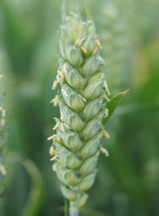
late boot early heading (25%) late heading (75%) late flowering (90%)
Wheat is most susceptible to midge damage when egg-laying occurs from early heading through pollination (Figure 8). As such, fields should be monitored daily from the time the heads begin to emerge from the boot until the anthers are visible.
Provided that economic threshold levels are present, the optimum stage to apply an insecticide is when 70 percent of the crop is headed. Applications prior to this growth stage will result in reduced control. In fact, if only 30 percent of the crop is headed, you should wait up to four days before treating. Likewise, applications made after 70 percent heading may result in reduced control.
Insecticides affect the adults as well as the emerging larvae as they eat through the outer integument of the egg. However, insecticides are not effective in controlling older larvae, which are protected within the floret of the wheat spike. As a result, insecticides applied when 75 percent of the plants have begun flowering do not provide adequate control. Further, late applications have the potential to kill beneficial parasitic wasps (page 7).
Insecticide application is recommended at dusk because female adults are most active at this time of day. However, early morning applications may also produce acceptable results. Thorough spray coverage is essential; application methods which improve the uniformity and amount of spray deposited on wheat heads provide better control.
Planting dates
Spring wheat is most vulnerable to attack from early heading through pollination. Planting as early as possible may help the crop to develop beyond the susceptible stage before the adults begin laying eggs. Selecting early maturing varieties also help the crop to develop sooner and avoid damage from the midge (Figure 9).
Canadian researchers have developed a model that estimates midge emergence and wheat growth based on accumulated degree-days. This information can be used to estimate the last advisable planting date. The following is provided only as a rough guideline to assist in scouting efforts.
The hibernating midge larva don’t become active until the threshold temperature of 40°F has been reached, and this is the temperature upon which the model is based.
Observations indicate that first 10 percent of females will have emerged after 1300 degree days have accumulated (Table 1). When using 40°F as the base temperature, spring wheat heading usually occurs at around 1000 to 1100 degree days. Spring wheat planted before 200 degree days have accumulated will typically head before peak midge emergence.
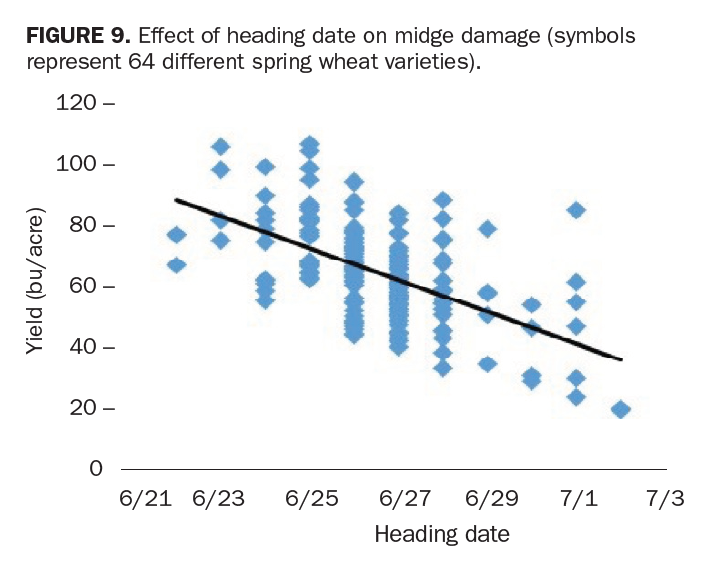
TABLE 1. Midge degree day model.
| Degree Days | Event |
| 450 | the midge breaks the larval cocoon and moves close to soil surface and forms the pupal cocoon |
| 1300 | 10% of the females will have emerged |
| 1475 | about 50% of the females will have emerged |
| 1600 | about 90% of the females will have emerged |
While this provides a rough estimate of when or when not to plant spring wheat, these predictions are only estimates. The accuracy of the model is dependent on the temperatures used in calculating degree-days, and the temperatures should represent the environment where the insects are developing. Temperatures at one site only give a rough estimate of insect development at another site a few miles away.
Several factors impact the accuracy of the model. First, soil temperature is affected by several variables including soil texture, tillage, residue cover, and topography. In addition to variable soil temperatures, crop development and maturity also varies with the spring wheat variety planted. Further, while temperatures generally drive the system, soil moisture is another critical aspect that impacts adult emergence.
All of these factors conspire together, making the use of degree-day models only rough estimates. Nevertheless, the model can be used to help eliminate unnecessary scouting and aid in making better management decisions.
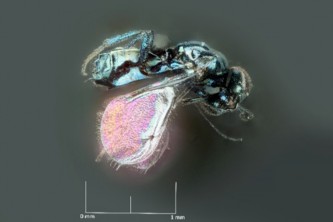
FIGURE 10. Midge parasitoid: Macroglenes penetrans (photo by WTARC, Conrad, MT)
Resistant Varieties
A single resistant gene called Sm1 has been identified that causes death of the larvae as they feed on the developing kernel. This is a highly effective gene, and in western Canada, wheat midge resistance based upon the Sm1 resistance gene has been successfully commercialized in spring wheat.
'Egan' hard red spring wheat (Reg. No. 1102, PI 671855) was developed by the Montana Agricultural Experiment Station, released in 2014 and is now commercially available to producers. Egan is resistant to wheat midge due to antibiosis conferred by resistance gene Sm1 and is intended for production in areas of Montana infested with the wheat midge.
Egan is so effective in destroying the midge that it requires mixing a small percentage of a susceptible variety with it to keep the midge from developing resistance or becoming a superbug. This combination of seed is also referred to as “refuge in a bag.” The refuge refers to the non-Egan seed that will attract the midge. It is the first-ever certified variety intended to be blended with other seed. Canadian and MSU entomologists suggest it be blended with 10 percent of a non-resistant variety to prevent the midge from developing resistance.
Biological Control
Fortunately, the expression "fight fire with fire" applies to the wheat midge. A small parasitic wasp (Macroglenes penetrans) attacks wheat midge larvae, helping to regulate populations.
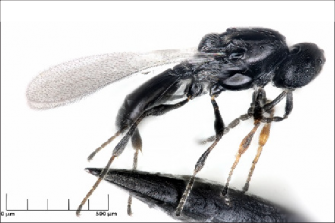
FIGURE 11. Midge parasitoid: Platygaster tuberosula (photo by WTARC, Conrad, MT)
The adult parasitic wasp is about ¹?10-inch long and metallic black. The adult female seeks out midge eggs in which to deposit their own eggs. The parasitized midge larva continues to feed on the developing wheat kernel, causing damage to the spring wheat crop during the current season. The mature midge larva drops to the soil, forms a cocoon and over-winters along with the dormant parasite inside its body. In the spring the wasp larva develops rapidly, consumes its host, and emerges as an adult in July.
Typically the wasp population lags behind the introduction of the midge by about one to three years, but once established, the impact can be considerable. This parasitoid is credited with controlling about 25 to 40 percent of the midge population in parts of Canada and North Dakota. In some instances, parasitism rates of greater than 75 percent have been documented.
In Montana, M. penetrans (Figure 10) has been established. Efforts to introduce two other parasitic wasps (Platygaster tuberosula, Figure 11, and Euxestonotus error, Figure 12) into Montana are ongoing. However, proper use and timing of insecticide applications will be critical to encouraging the establishment of the wasp. Insecticides should only be used if current year populations of the wheat midge exceed the economic threshold. And insecticide use should be avoided if the crop has reached 75 percent flowering.
Summary
There are several tools available for managing the midge. Each individual management tactic has merit. But, as with most pest problems, an integrated approach that uses a combination of methods will be necessary in order to minimize damage from the wheat midge.
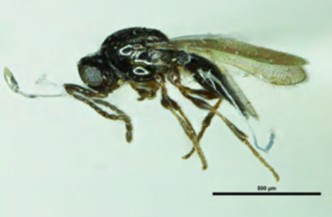
FIGURE 12. Midge parasitoid: Euxestonotus error (photo by Tyler Wist, Canada)
For further information, contact the Western Triangle Agricultural Research Center at 406-278- 7707 or online, http://agresearch.montana.edu/wtarc/index.html
Common chemical and trade names are used in this publication for clarity of the reader. Inclusion of a common chemical or trade name does not imply endorsement of that particular product or brand of herbicide and exclusion does not imply non-approval.

